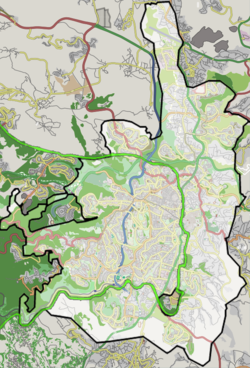Rehavia
Rehavia
רחביה | |
|---|---|
Neighborhood of International style architecture in Rehavia | |
| Coordinates: 31°46′28.11″N 35°12′43.19″E / 31.7744750°N 35.2119972°E | |
| Country | |
| District | Jerusalem District |
| City | Jerusalem |
| Founded | 1922 |
| Founded by | Jewish National Fund |

Rehavia or Rechavia (
Name

The neighborhood was named by Eliezer Yellin, its first inhabitant and one of its early architects, after Moses' grandson, "Rehavia",[1] (1 Chronicles 23:17, 24:21, 26:25).
History
Rehavia was established on a large plot of land purchased in 1921 from the
The Jewish National Fund (JNF) bought the land and commissioned the German-Jewish architect Richard Kauffmann to design a garden neighborhood.[3] Kauffmann, who referred to it as the Janziriah project, prepared plans for a neighbourhood featuring homes surrounded by gardens and an orderly, but not too strict, grid of streets and footpaths on either sides of a main boulevard, avoiding an excessive sense of symmetry.[3]
For legal reasons the land was transferred back to the PLDC in exchange for lands in the
The first phase, called Rehavia Aleph, was bordered by King George Street to the east,
The prime minister's official residence is "Aghion House", at No. 3 Balfour Street, on the corner with Smolenskin Street.[5]
Demographics
When the Ethiopian emperor
Landmarks

Landmark buildings in Rehavia include the headquarters of the Jewish Agency for Israel, the windmill on
In the center of historic Rehavia is Yad Ben-Zvi, a research institute established by Ben-Zvi. Jason's Tomb was discovered during construction work on Alfasi Street.[8] The Schocken library in Rehavia, assembled by the German-Jewish editor Salman Schocken, houses the largest collection of German books in the country.[9]
Street names
Most of Rehavia's streets are named after Jewish scholars and poets from the
Notable residents
- Avraham Burg
- Eliezer Igra
- Emanuel Feldman
- David Flusser
- Haile Selassie, Emperor of Ethiopia
- Moshe Goshen-Gottstein
- Moshe Greenberg
- Erich Mendelsohn
- Benjamin Netanyahu (born 1949), Prime Minister
- Menachem Ussishkin (1863-1941), Zionist leader and head of the Jewish National Fund
- Berel Wein, rabbi
- Daphni Leef, activist
- Reuven Rivlin, President of Israel[12]
- Robert Aumann, Nobel prize winner[13]
- Miriam Naor, President of the Supreme Court of Israel[14]
- David Kroyanker
Gallery
-
Laying of foundation stone at start of expansion of Rehavia, 1947
-
Rehavia 1928
-
Jewish Agencybuilding, Rehavia
-
Windmill on Ramban Street
-
Home of Menachem Ussishkin, Ramban Street
References
- ^ a b Bar-Am, Aviva; Bar-Am, Shmuel (August 15, 2015). "How Ramban's 'desolate' Jerusalem area transformed into yekkes' Rehavia". The Times of Israel.
- ^ a b c "Rehavia & Makor Haim". Jewish Virtual Library. 2011. Retrieved 26 February 2011.
- ^ a b c Inbal Ben-Asher Gitler, "Marrying Modern Progress with Treasured Antiquity": Jerusalem City Plans during the British Mandate, 1917-1948, in Traditional Dwellings and Settlements Review, Vol. 15, No. 1 (FALL 2003), p. 47 (entire article: pp. 39-58), published by: International Association for the Study of Traditional Environments (IASTE)
- ^ a b c "Focus on Israel: Jerusalem – Architecture in the British Mandate Period". Israel Ministry of Foreign Affairs. 1 July 1999. Retrieved 26 February 2011.
- ^ Riba, Naama (October 2, 2022). "Jerusalem's Rehavia Celebrates a Century – and Fears for Its Future". Haaretz.
- ^ Daniel Jacobs, The Rough Guide to Jerusalem, 2009, p.300
- ^ Pfeffer, Anshel (27 March 2008). "Bible club founded by Ben-Gurion gets revived with a Peres twist". Haaretz. Retrieved 13 August 2018.
- ^ Jerusalem tombs
- ^ "Ghosts of Rehavia's Zeitgeist".
- ^ Rubinstein, Danny (26 November 2006). "A walk across Jerusalem history". Haaretz. Retrieved 26 February 2011.
- ^ Dotan Goren, Et-Mol 247 (August 2016), pages 23-26 (in Hebrew). There is a different version, according to which Rechov Ussishkin was previously called Rechov Yehuda HaLevy, see Kurtz, Chani. "Road of Remembrance: Street names and their stories". Binah Pesach supplement, 2015, p. 54. However, the historical documents show this version is incorrect. In particular, Yehuda HaLevy is the former name of Gan HaKuzari in Rehavia.
- ^ "Reuven Rivlin - from Beitar to the President's Residence". 10 June 2014.
- ^ "He's got game".
- ^ "Miriam Naor, new president of the Israel's Supreme Court, is a woman with a mission".






